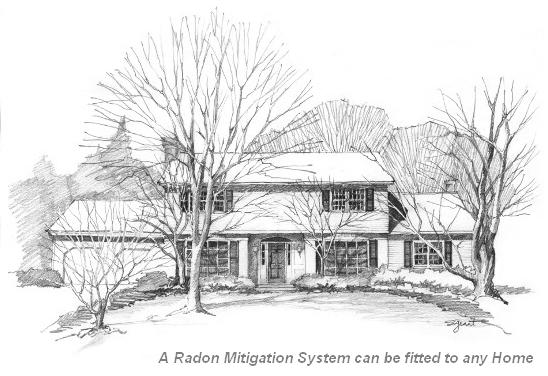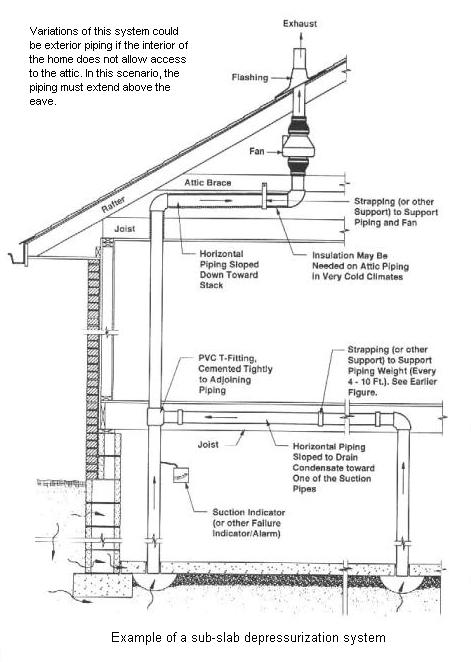
RADON MITIGATION
Your Home Can Be Treated To Prevent Radon From Entering
Okay, so you have tested your home and found radon! Don't be overly alarmed. Be concerned, but realize that a radon mitigation system can help eliminate the high radon levels in your home.

There are many avenues available to you to diminish or eliminate radon in your home.
According to the EPA recommendations, you should consider radon mitigation if your test came back 4 pCi/l or higher. We recommend mitigation if the test level is 2 pCi/l or higher.
Radon mitigation techniques are very effective and most are very affordable. And they won't require tearing down your house, or major remodeling.
To quote the EPA,"The average house costs about $1,200.00 for a contractor to fix (for radon mitigation), although this can range from about $800.00 to about $2,500.00, depending on the characteristics of the house and the method used."
A fan based radon mitigation system, or sub-slab depressurization system, seems to be one of the most practical and effective systems to consider.
- Radon reduction 80%-99%
- Cost is $800 to $2,500 depending upon your particular home.
- This system does require electricity, which can cost as much as $175 per year.
- Fans occassionally need service or replacement,
- A visible piping system can be unsightly and devalue your home for resale. Blend your system in with your home's architecture and surroundings.
- Some loss of heating and air conditioning through the system to the exterior. This will increase your utility bills.
- The fan must run continuous. A warning device should alert you if the system fails.
- This system requires that holes be drilled through the slab for the suction side of the system, preferrably centrally located in your basement.
Fortunately, many builders have become aware of radon permeation into homes, and are introducing radon resistant techniques into their structures. A gas permeable layer of gravel beneath the slab will allow gas to move freely underneath the home. A layer of plastic sheeting beneath the slab and over the layer of gravel helps prevent radon entry into the home.
A common error in radon remediation is the approach that basement ventilation is a cure-all. For some homes this may be a viable solution. But depending upon the tightness of your home, this approach may actually increase the flow of radon from the ground into your home.
Another common error is the belief that particular paints or sealers can block radon. The EPA has tested virtually all paints and sealers and has concluded that they are not effective, with the possible exception of deep penetrating concrete sealer.
The above mentioned sub-slab depressurization system is certainly not the only approach to the radon problem. Following is other possible approaches and options, along with estimated effectiveness and estimated costs.
- Caulk cracks, slab joints, and other possible entry points, such as around basement windows. Effectiveness 0% to 50% with a price tag of $100 to $600.
- Natural ventilation through vents or windows. Cost can be $200 to $500 for additional vent installation, but costs more in comfort system operating costs. Effectiveness variable.
- Heat recovery ventilation can be 25% to 75% effective. Installation cost ranges from $1,500 to $3,000. This type of system should run continuously.
- Basement pressurization system has unpredictable results ranging from 50% to 99% effectiveness. Cost should range from $500 to $1,800.
- Deep penetrating concrete sealer. If your concrete slab and foundation walls are accessible, this sealant can be 80% to 99% effective at a mid-range price of $600.
- A Sump hole fan suction system can be highly effective, up to 99% at a cost of $1,000 to $2,500.
- A drain tile suction system with a fan requires that drain tiles form a complete loop around the basement. Tiles are placed surrounding the foundation and pull radon from the soil, to then be vented away from the house. This system can be as high as 99% effective. Estimated cost is $1,800.
Whatever approach you choose, test and retest. We recommend that you consult and hire a professional radon mitigation expert, and that a warning device be a required component of any system.
Check your system and warning device regularly to ensure that radon levels are controlled.

Leave our Radon Mitigation page and return to main Radon page
Return to Indoor Air Quality page
Return to HOME

Please feel free to link to this page from your website. This page's URL is: http://www.perfect-home-hvac-design.com/radon-mitigation.html
Enjoy this page? Please pay it forward. Here's how...
Would you prefer to share this page with others by linking to it?
- Click on the HTML link code below.
- Copy and paste it, adding a note of your own, into your blog, a Web page, forums, a blog comment,
your Facebook account, or anywhere that someone would find this page valuable.